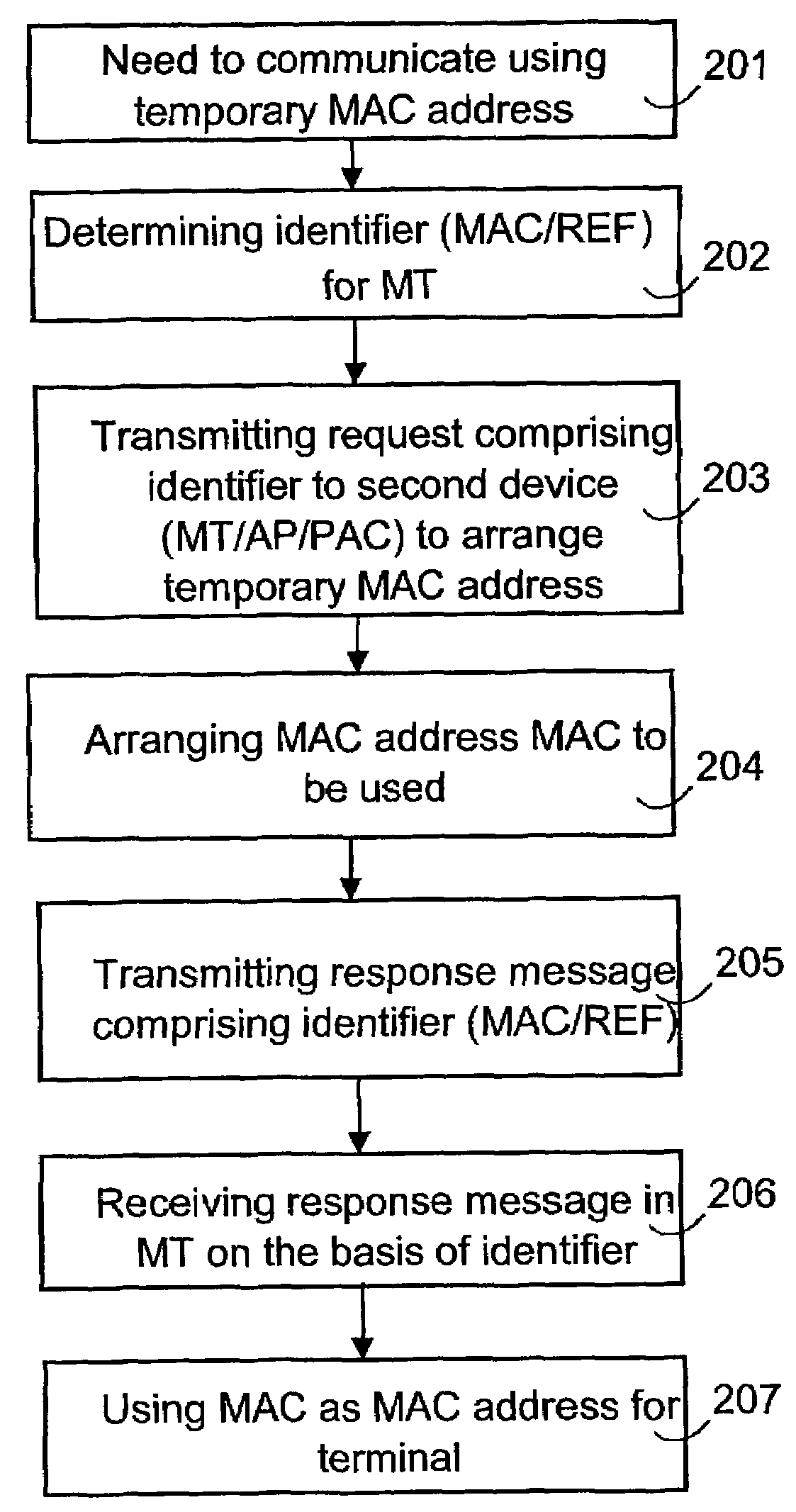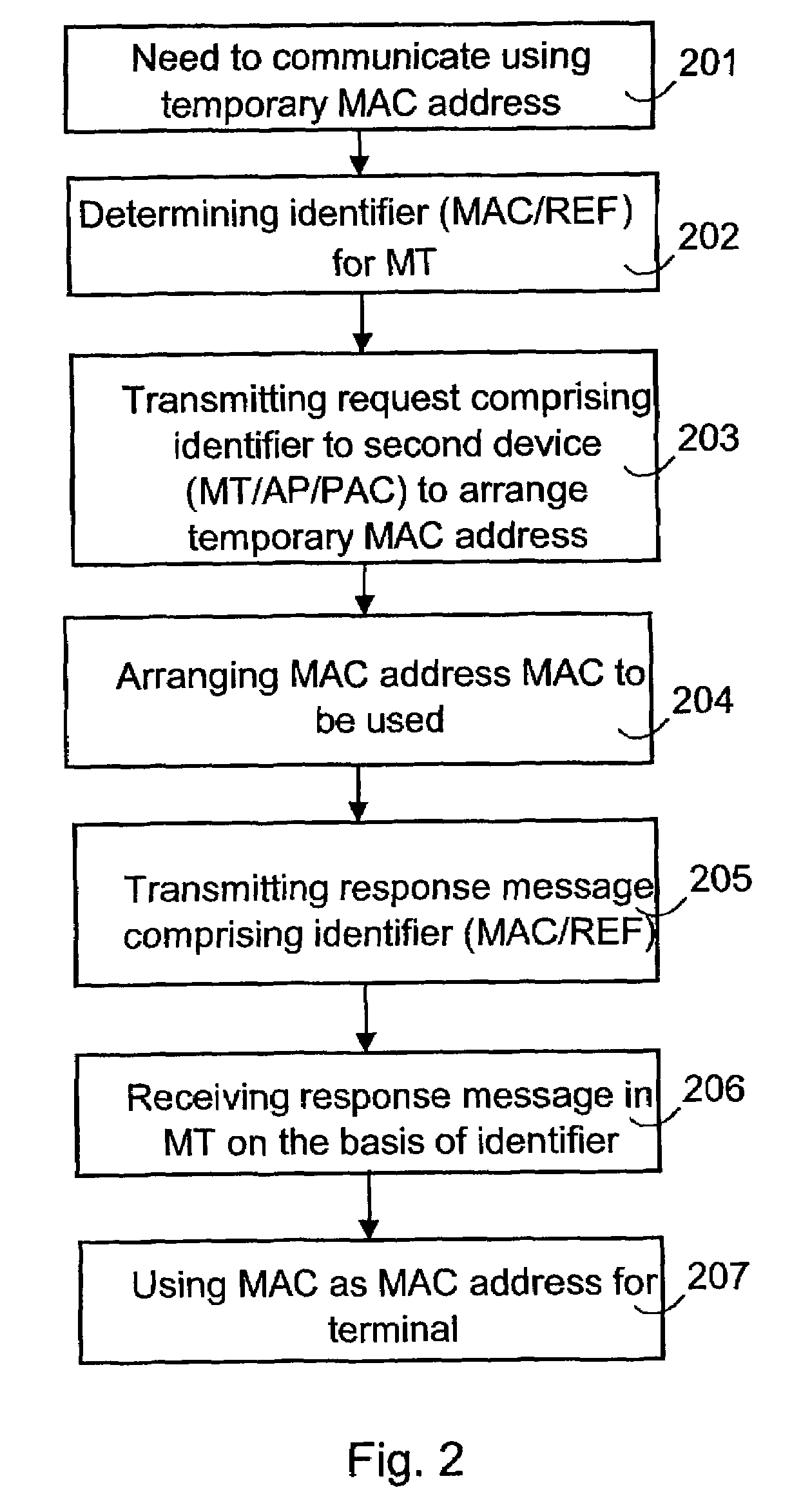Addressing in wireless local area networks
a wireless local area network and wireless technology, applied in multiplex communication, data switching networks, instruments, etc., can solve the problems of security risk and its traffic being deliberately disturbed, and achieve the effect of reducing collision risk, ensuring uniqueness of suggested mac addresses, and reducing probability of such an even
- Summary
- Abstract
- Description
- Claims
- Application Information
AI Technical Summary
Benefits of technology
Problems solved by technology
Method used
Image
Examples
first embodiment
[0028]FIG. 3 illustrates a flowchart of the functionality in terminal MT and second device communicating with it, i.e. an access point AP or a public access controller PAC, in a first embodiment, in which the MT itself selects the MAC address.
[0029]When there is a need to communicate with the access point AP (to join a BSS network or an ESS network), an MT according to the IEEE 802.11 standard can find the available access points AP either with active or passive scanning. In passive scanning, the MT selects the access point AP to be used on the basis of Beacon messages received from the access point AP. In active scanning, the terminal MT transmits a Probe request. In this request, a well-known MAC address reserved for anonymous terminals, preferably a multicast address, is used as the source address of the MAC layer of the MT, because the MAC address fixedly allocated to the MT is not to be revealed (or does not exist). The access points AP respond to this with Probe responses, whi...
second embodiment
[0053]FIG. 4 illustrates a second embodiment, in which a network, preferably an access point AP, determines the temporary MAC address MAC. Also in this embodiment, the terminal MT can use both active and passive scanning to find a suitable access point AP. In passive scanning, the AP transmits 401 Beacon messages in which support is preferably indicated to temporary MAC addresses. On the basis of the received Beacon messages, the MT selects the access point AP to be used from the access points AP. In active scanning, the terminal MT transmits 402 a Probe message to the access points AP. In this request, a well-known source MAC address, preferably a multicast address, is used. The access points AP respond 403 to this with a Probe response, which is not acknowledged. Preferably, the Probe response indicates support to temporary MAC addresses. The terminal MT selects the access point on the basis of the received Probe responses. When the terminal MT detects that the AP supports the use...
third embodiment
[0059]FIG. 5 further illustrates a third embodiment, in which temporary MAC addresses are arranged between two (or more) terminals MT. Having determined 501 the temporary MAC address MAC in the way described in connection with FIG. 3, for example, the MT transmits 502 to one or more other terminals a challenge message relating to the acquisition of the MAC address and comprising the MAC address MAC to be suggested. Preferably, MAC is the MAC layer address of the challenge message, and a well-known multicast address is the source address. The challenge message comprising the MAC can alternatively be transmitted to a multicast address. The MT observes 503 whether an acknowledgement of the challenge message is received. If the address MAC in question is used by some other terminal MT, the terminal receives a message and is arranged to respond to and acknowledge it for example with an ACK message, which is shown in more detail in FIG. 6. If this acknowledgement relating to the acquisiti...
PUM
 Login to View More
Login to View More Abstract
Description
Claims
Application Information
 Login to View More
Login to View More - R&D
- Intellectual Property
- Life Sciences
- Materials
- Tech Scout
- Unparalleled Data Quality
- Higher Quality Content
- 60% Fewer Hallucinations
Browse by: Latest US Patents, China's latest patents, Technical Efficacy Thesaurus, Application Domain, Technology Topic, Popular Technical Reports.
© 2025 PatSnap. All rights reserved.Legal|Privacy policy|Modern Slavery Act Transparency Statement|Sitemap|About US| Contact US: help@patsnap.com



